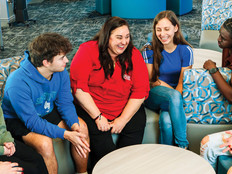How Flexible Furniture Influences Learning
“Education, in general, is one of the most resistant and stubborn-to-change entities in the world,” says Mike Patterson, a K–12 education strategist at CDW•G. He speaks from experience; before joining the company, Patterson spent a decade as a teacher and school administrator.
He’s seen the resistance that new technology often faces upon introduction to a school setting — and he’s seen how teachers who sign on to a pilot may struggle to break old habits or to find the best way to incorporate the tech into their teaching.
The result is students who aren’t ready for the future. “K–12 has not necessarily been preparing students for the workforce,” Patterson says, noting that students who are deskbound in traditional classrooms aren’t practicing the collaborative, mobile methods of modern workplaces.
The National Education Association has identified “the four C’s” — critical thinking, communication, collaboration and creativity — that are crucial for success in the 21st century. These skills, more so than narrow preparations in the form of specific certifications or training on platforms, are the ones that will make students adaptable for a future that is still being written.
Here’s another problem: If students remain stuck in rows of desks, mobile technology in that isolated atmosphere can actually exacerbate a lack of communication and collaboration in a classroom.
But there’s a solution that helps sidestep the potential isolating effects of mobile technology: the standing desk.
Designing Standing Desks to Fit K–12 Classrooms
As research began to reveal the dangers of excessive sitting — one doctor coined the phrase “Sitting is the New Smoking” to describe the detrimental effects — the business world embraced standing and variable-height desks, such as the Ergotron WorkFit line. But these desks needed to be reimagined before they could spread to schools.
Unlike the WorkFit sit-stand desks, the LearnFit series needed to stand up to hard use by multiple students over multiple years, says John Erickson, a senior production manager at Ergotron. And, unlike office furniture that mostly remains stationary, the LearnFit desk needed to move.
After piloting the initial design, Ergotron solicited feedback from educators across the country. The final product included a caster system and easy height adjustment, the keys to supporting an active, collaborative learning environment.
The LearnFit desks cost more than a standard sit-down desk, Erickson says, but Ergotron packed the design with additional features to ensure that it met the needs of students and teachers. There’s a water-bottle holder, a pencil tray, a backpack hook and, optionally, a cubby for extra storage. The goal is to make sure everything a student needs is there at the desk, cutting down on disruptions during the day and maximizing instructional time.
For the sit-stand LearnFit desk, the height adjustment range is designed for students ages 12 through adult — an important feature given that these are the students who usually spend upward of seven hours of their school day at a desk. For younger students ages 6 and up, Ergotron offers an adjustable standing-only version.
The feedback from schools has been overwhelmingly positive. Erickson recently visited a fourth-grade classroom; students and teachers there told him that if they had the option only to sit or to stand, they would choose to stand.
“We think that’s a strong message that they really like the standing solution,” he says.
Patterson sees in mobile furniture a way to tackle three of the four C’s: collaboration, communication and creativity. Students given mobile devices in a traditional classroom setting may get trapped in a pattern of focusing on their screens instead of interacting with each other.
Collaborating and communication are enhanced when students can easily move to face each other.
“Communication and communication skills are huge,” says Patterson. “Because technology has taken such a stranglehold on how we talk and interact with each other, these types of things are going to afford opportunities for students to communicate more openly and comfortably.” But he sees specific opportunity in the realm of creativity.
“The students will have the option of connecting with people in other parts of the room. As obvious as it sounds, if you think about a traditional classroom, students can be siloed — basically sitting around the same three or four people for a majority of the semester,” says Patterson.
“If you’re giving your kids the ability to interact with other people within the classroom, you’re allowing them to inspire each other in a variety of ways,” he adds.
Following Effective Business Design Produces Healthy Outcomes
Patterson hears one word over and over again when he speaks to school administrators: Starbucks.
The coffee chain has in many ways become ubiquitous with 21st-century styles of work. Patterson recently worked with a school district of 69,000 students in Texas; administrators specifically cited the brand when describing the warm, inviting, option-rich atmosphere they hoped to recreate in their new classrooms.
“It has become the default model, because it has flipped our definition of a place where we can be comfortable and productive,” he says, adding that schools that want to transform their spaces and equip students for the future could do worse than look at places where people love to go to work. If students have the option to move and stand throughout the day, it’s not just engaging — it’s also healthy.
According to a meta-analysis of studies involving students and standing desks published in the January 2016 issue of Pediatrics, introducing sit-to-stand desks into classrooms cut around an hour’s worth of sitting out of a student’s day. The researchers also noticed that students who stand more throughout the day burned more calories; this increase was particularly marked in children diagnosed as obese.









